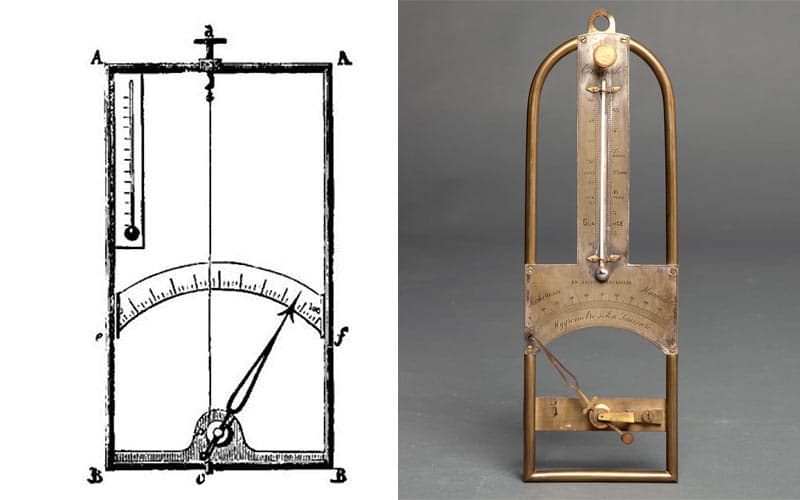The customer service team is always listening, taking notes, and quantifying complaints to ensure our products are continually improved. Due to selling directly to you, the customer, via Amazon, we can use product reviews to help us improve our existing products or help further development of new products.
How to Use a Hygrometer and How Does It Work
Table of Contents
To fully understand how to use a hygrometer, it helps to know when and where you can use it. A hygrometer is an essential instrument in meteorological science. It has numerous commercial uses, but the primary purpose of the device is to measure the amount of water vapor (humidity) in the air. The primary use of the instrument is to provide the amount of moisture in the air and compares that number to the maximum amount of moisture that the air, confined space, or soil can potentially contain. If you have this question, “How does a hygrometer work?” here is the answer. Just like other instruments used for measuring humidity, hygrometers work by relying on other quantities or measurements of temperature, mass, and pressure among others as these things absorb moisture.
Hygrometers have become a popular device in industrial spaces and greenhouses. These days, however, they are also used in museums, humidors, saunas, and incubators. Moisture can harm wooden musical instruments, which is why hygrometers are also used in caring for pianos, violins, harps, and guitars among others. Meanwhile, homes can benefit from hygrometers because they can guide the residents on humidity control. Very low humidity can negatively impact the skin and the body. On the other hand, too high humidity encourages mildew and dust mites to proliferate. With the help of hygrometers, homeowners can figure out a way to control moisture in their surroundings. The paint industry also sees the importance of hygrometers. Paint applications, for instance, can be quite sensitive to both dew point and humidity.
What is a Hygrometer?
Hygrometers are considered weather instruments that can measure humidity. Over the centuries, these instruments have changed, advanced, and have taken different varieties to suit the users’ needs. It was in the 1400s when one of the very first models of hygrometers appeared. Leonardo da Vinci constructed his early version of this device in which his goal was to measure the moisture in the air.How the Hygrometer Work
Today, there are different types of a hygrometer and how they work will depend on their design. For instance, one of the types is a capacitive hygrometer. Devices classified under this form use different other types of sensors. Capacitive hygrometers are created for applications where price, fragility, or space is a concern, so they risk the accuracy of reading moisture for the affordability of the device. Capacitive hygrometers measure the effect of moisture on a metal oxide material. Frequently, they are also used for quantifying humidity’s impact on the dielectric constant (or the relative permittivity) of a polymer, such as synthetic plastics. When calibrated, the sensors have an accuracy rating of ±2% relative humidity within the range of five to 95% relative humidity. If not calibrated, the accuracy is up to three times worse. The sensors though can withstand high temperatures and the effects of condensation, and they are suitable for various applications. However, these capacity hygrometers have sensors that can easily be contaminated and show signs of aging rapidly. Another sensor is resistive, which is less sensitive when compared to capacitive sensors. These sensors measure the changes in a material’s electrical resistance, which humidity in the environment causes. Since they are not as sensitive as capacitive, resistive sensors require a more complex circuit board. The accuracy depends on the resistive material used but is usually up to ±3% relative humidity. The material also dictates how robust the hygrometer will be against condensation.What is a Hygrometer Used For?
Hygrometers are deemed as useful tools, which utilize calculation and calibration of pressure and temperature changes. Combined together, the resulting percentage will be the amount of moisture in the air. A hygrometer is a helpful device in office buildings and homes, as well as in manufacturing and industrial processes. These areas need to ensure that no change in humidity will occur, since it may affect the production of materials. The use of the hygrometer depends on the type, which includes the following:Psychrometers:
Electrical hygrometers:
Dewpoint hygrometers:
Hygrometers have become a popular device in industrial spaces and greenhouses. These days, however, they are also used in museums, humidors, saunas, and incubators. Moisture can harm wooden musical instruments, which is why hygrometers are also used in caring for pianos, violins, harps, and guitars among others. Meanwhile, homes can benefit from hygrometers because they can guide the residents on humidity control. Very low humidity can negatively impact the skin and the body. On the other hand, too high humidity encourages mildew and dust mites to proliferate. With the help of hygrometers, homeowners can figure out a way to control moisture in their surroundings. The paint industry also sees the importance of hygrometers. Paint applications, for instance, can be quite sensitive to both dew point and humidity.
How to Use a Hygrometer: Reading the Device
Whether you will use a hygrometer for weather observation or measuring conditions for indoor spaces, it makes sense to know how to read one. To get the best and most accurate results, these devices need to be calibrated at least once every year.- Dry bulb temperature
- The temperature of the wet bulb
- Wet bulb depression (the difference between the first and second temperatures)
















